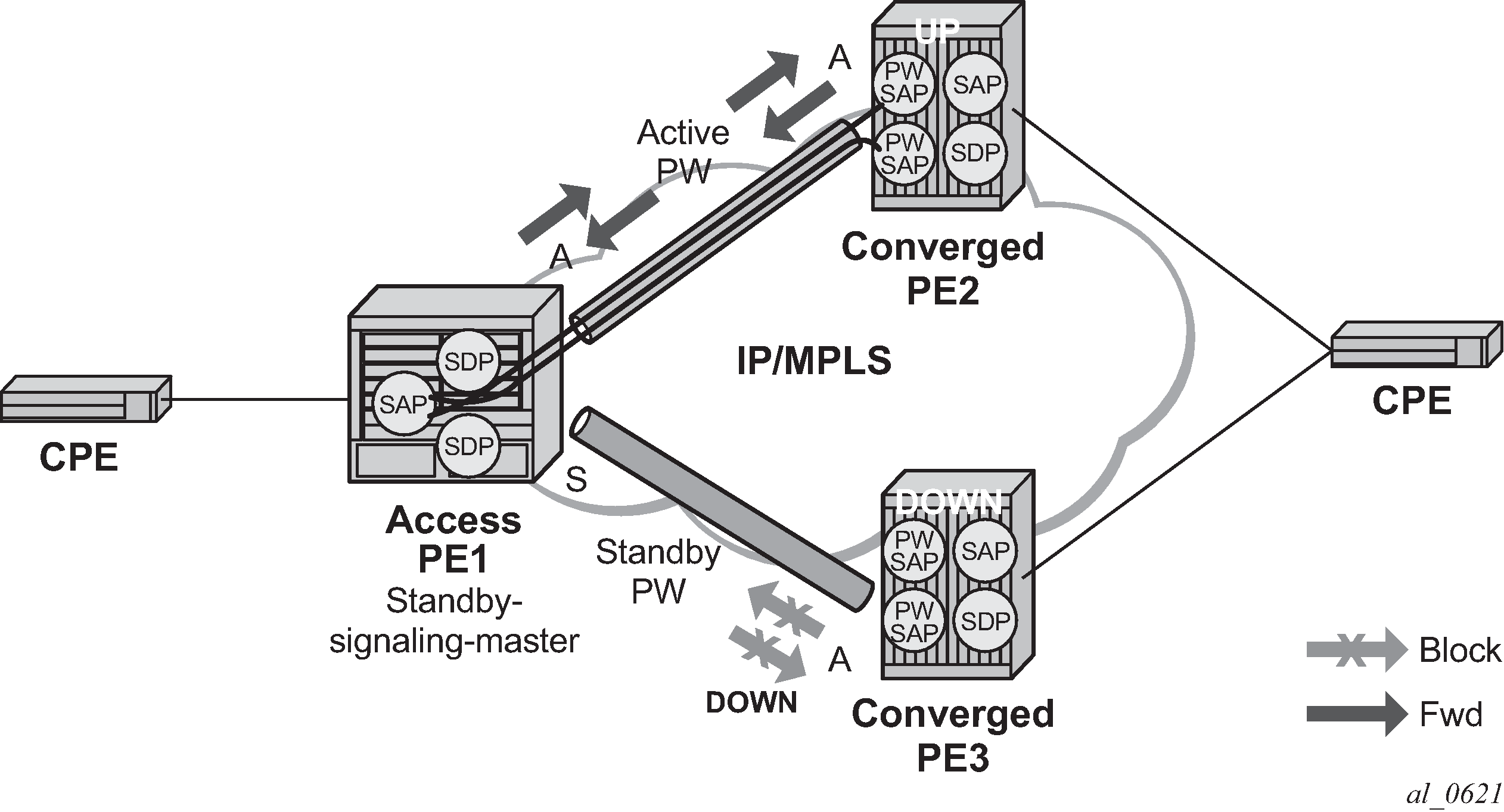This section describes a mechanism in which one end on a pseudowire (the "master") dictates the active PW selection, which is followed by the other end of the PW (the 'slave'). This mechanism and associated terminology is specified in RFC6870.
Within a chassis, IOM and port based redundancy is based on active/backup LAG. The topology for the base MPLS LSP used by the SDP could be constrained such that it could get re-routed in the aggregation network, but would always appear on the LAG ports on the Layer 3 PE. In the case that the tunnel is re-routed to a different port, the MPLS pseudowire SAPs would be brought down.
To provide Layer 3 PE redundancy, dual homing of the access PE into separate Layer 3 PEs using active/standby pseudowire status is supported. This is shown in Figure: Dual homing into multiple Layer 3 PEs.

Dual homing operates in a similar manner to Spoke-SDP termination on IES/VPRN. Figure: Dual homing into multiple Layer 3 PEs displays the access PE is dual-homed to the Layer 3 PEs using two spoke-SDPs. The endpoint in the access PE is configured to be the master from a pseudowire redundancy perspective using the standby-signaling-master command. The access PE picks one of the Spoke-SDPs to make active, and one to make standby, based on the local configuration of primary or spoke SDP precedence.
The pseudowire port at the Layer 3 PE behaves as a slave from the perspective of pseudowire status signaling. That is, if its peer signals ‟PW FWD standby (0x20)” status bit for the specific Spoke-SDP and the local configuration does not allow this bit to be ignored, the PE takes the pseudowire port to a local operationally down state. This is consistent with the Spoke-SDP behavior for the case of Spoke-SDP termination on IES/VPRN.
As a consequence, all of the pseudowire SAPs bound to the pseudowire port are taken down, which causes the corresponding IES or VPRN interface to go to a local operationally down state and therefore stops forwarding packets toward this pseudowire port.
Conversely, the formerly standby pseudowire is made active and then the corresponding pseudowire port on the second Layer 3 PE is taken locally operationally up. Therefore, all of the pseudowire SAPs bound to the pseudowire port are brought up, which causes the corresponding IES or VPRN interface to go to a local operationally up state allowing forwarding of packets toward this pseudowire port.
For VLLs, a PW port always behaves as a slave from the perspective of PW redundancy. This is because the PW port is taken locally operationally down if any non-zero PW status (including a PW Preferential Forwarding status of standby) is received. Master-slave PW redundancy mechanisms for dual homing of the access PE into separate converged PEs using active or standby PW status are supported as shown in Figure: Master-slave PW redundancy . However, this is only applicable to VLL services consisting of only SAPs, PW-SAPs, or spoke-SDPs. Dual-homing redundancy, taking into account the status of the PW SAP, is not supported where a PBB tunnel between the two converged PEs exists in the Epipe VLL service.

As in the existing implementation, standby-signaling-master is configured on the Spoke-SDP at the access PE. However explicit configuration of standby-signaling-slave on the PW port is not required, as this is the default behavior.
The forwarding behavior is the same as when standby-signaling-slave is configured for Epipe Spoke-SDPs. That is, when enabled, if a PW Forwarding Standby (0x20) LDP status message is received for the P11111111W, then the transmit direction is blocked for the PW port. All PW SAPs bound to the corresponding PW port are treated from a SAP OAM perspective in the same manner as a fault on the service, such as an SDP-binding down or remote SAP down.
PW redundancy with multiple active/standby PW ports or PW SAPs bound to the same Ethernet SAP in the converged PE is not supported. The independent mode of operation for PW redundancy is not also supported for a PW port.